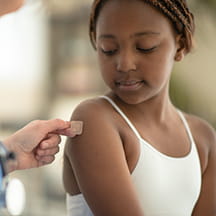While it was otherwise a routine conversation with a patient’s parent, one comment conveyed a feeling that Ashley Mangum says she’ll never forget.
“They told me, ‘We don’t need another door to an empty room,’” says Mangum, MSW, director of Kids’ Mental Health Pierce County (KMHPC) and behavioral health social worker at Mary Bridge Children’s Hospital in Tacoma, Washington.
It reflected the frustration parents can sometimes feel when offered a litany of services and resources to help their child in a behavioral health crisis, but not knowing how to navigate the complexities and nuances of the support system.
And it helps guide the work Mangum and her colleagues perform in the KMHPC collaborative.
A comprehensive approach
In 2018, Mary Bridge Children’s hosted a summit to address the growing children’s mental health crisis in its community—at that time, the hospital was experiencing a 400% increase in emergency department visits over a three-year period due to mental health crises.
More than 70 leaders and frontline staff across multiple disciplines—including emergency services, law enforcement, juvenile justice, behavioral health, education and social services—participated in the summit with the goal of developing a coordinated, responsive behavioral health system to serve the needs of the area’s children and adolescents. The result was KMHPC, a coalition that today includes 800 members spanning more than 60 community agencies.
Among its primary objectives:
- Developing a one-stop collaborative that serves as a single point of access to child and adolescent mental health service.
- Increasing support and expansion of mobile crisis response teams.
- Promoting and supporting workforce development and continued training in child and adolescent mental health.
In addition to monthly meetings to advance the organization’s shared agenda, KMHPC convenes regular multi-disciplinary team meetings (MDT) to discuss and execute on solutions for specific cases. Mangum says the MDTs are a shining example of the commitment level of collaborative members—even on short notice, it’s not uncommon for more than 30 professionals to join an MDT to help a child in need.
“So often in these forums you hear a parent say they’ve never had this many people show up for their child,” Mangum says. “That sentiment demonstrates why people continue to volunteer their time for these MDTs; they recognize them as a way to essentially link our arms and create a safety net that hasn’t existed before within our community.”
Replicating the collaborative’s success
The program has garnered attention around the state. KMHPC earned the 2021 Program of the Year award from the Washington state chapter of the National Alliance on Mental Illness (NAMI). And it has received funding from the state government to not only fund the program moving forward but to also assist other communities in replicating it.
“We know that every community is going to be unique, but they all have their own resources and champions,” Mangum says. “Every community can come together to get out of those silos of just saying ‘those are your kids’—these are really all our kids, and they all deserve to be well as close to home as possible.”



